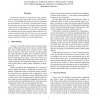Free Online Productivity Tools
i2Speak
i2Symbol
i2OCR
iTex2Img
iWeb2Print
iWeb2Shot
i2Type
iPdf2Split
iPdf2Merge
i2Bopomofo
i2Arabic
i2Style
i2Image
i2PDF
iLatex2Rtf
Sci2ools
WACV
2002
IEEE
2002
IEEE
Activity maps for location-aware computing
Location-based context is important for many applications. Previous systems offered only coarse room-level features or used manually specified room regions to determine fine-scale features. We propose a location context mechanism based on activity maps, which define regions of similar context based on observations of 3-D patterns of location and motion in an environment. We describe an algorithm for obtaining activity maps using the spatio-temporal clustering of visual tracking data. We show how the recovered maps correspond to regions for common tasks in the environment and describe their use in some applications.
| Added | 16 Jul 2010 |
| Updated | 16 Jul 2010 |
| Type | Conference |
| Year | 2002 |
| Where | WACV |
| Authors | David Demirdjian, Konrad Tollmar, Kimberle Koile, Neal Checka, Trevor Darrell |
Comments (0)

